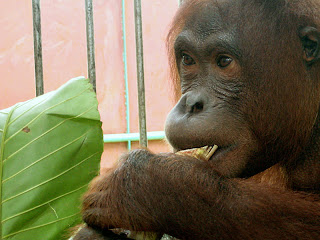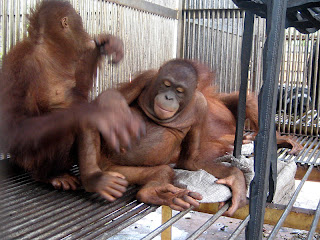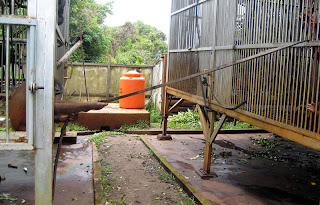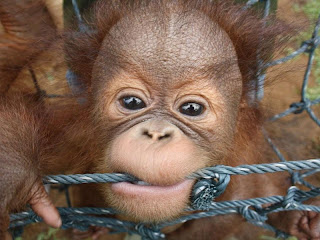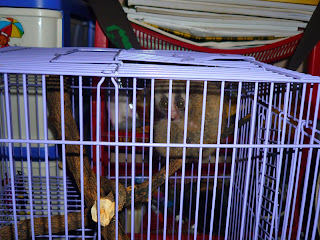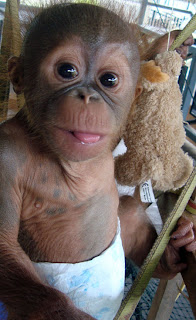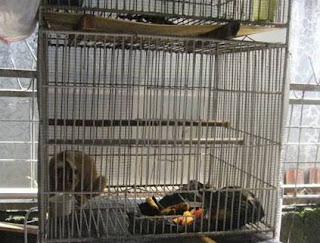Puyol
 When our team first rescued one-year-old Puyol last week, his condition was stable but he was in dire need of veterinary care. Puyol was taken from his mother about two months ago by poachers and the incident was likely quite violent given the infected machete wounds on Puyol's abdomen and arms. Doctors Karmele, Anita, and Adi cleaned up Puyol's wounds and began treatments immediately for infection and malnutrition. The day of Puyol's rescue, he immediately latched onto Dr Karmele, and devoured bananas and formula with glee. Giving medication was never a problem since Puyol has been such a good eater. The keepers and volunteers have been toeing the line between showering Puyol with attention and encouraging him to play and climb with our other new baby orangutans Jack and Ledi. It is important to meet any baby's emotional needs, but also very important to begin training for baby school and hopefully an eventual reintroduction into the wild.
When our team first rescued one-year-old Puyol last week, his condition was stable but he was in dire need of veterinary care. Puyol was taken from his mother about two months ago by poachers and the incident was likely quite violent given the infected machete wounds on Puyol's abdomen and arms. Doctors Karmele, Anita, and Adi cleaned up Puyol's wounds and began treatments immediately for infection and malnutrition. The day of Puyol's rescue, he immediately latched onto Dr Karmele, and devoured bananas and formula with glee. Giving medication was never a problem since Puyol has been such a good eater. The keepers and volunteers have been toeing the line between showering Puyol with attention and encouraging him to play and climb with our other new baby orangutans Jack and Ledi. It is important to meet any baby's emotional needs, but also very important to begin training for baby school and hopefully an eventual reintroduction into the wild.The other night, I tried to get Puyol to sleep in his hammock playpen by sitting next to him until he fell asleep. It took about 20 minutes just to get him off my lap without a fuss, and about a half hour later he fell asleep. I went to cover the top of his sleeping area with a towel in the hopes that he would sleep more soundly, but as soon as he sensed movement his head shot up and he gave a look that to me quite clearly meant, "Ummm, I'm not asleep yet. Don't you dare think of tricking me with that towel and walking away." I remember giving similar looks to my poor mother as a child, so I felt it was time I returned the favor. Puyol's head rested again on his teddy bear as soon as he saw me sit down again, and within ten minutes he was out. Success!
Jack and Ledi
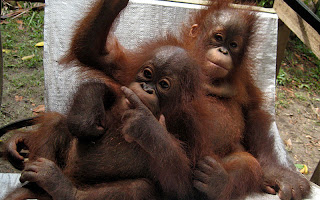 Orangutans Jack and Ledi were rescued the same day as Puyol, but luckily they had been kept as pets under better conditions. Both Jack and Ledi are already fantastic climbers and they spend most of their day playing in the trees and swinging on ropes at our rehabilitation center. Watching them can be exhausting though, since Jack has become quite naughty about pulling hair the second your back is turned. He loves the attention and of course the reaction, so you've got to stay on your toes. Ledi wanted nothing to do with this type of horseplay when she first arrived, and she would hoot and holler at the sight of any play-wrestling that she misinterpreted as conflict. It didn't take long for Ledi to get used to it, however, since she has since joined in on the hair pulling sneak attacks. "At least they're healthy," I think to myself. "Very naughty, but healthy indeed."
Orangutans Jack and Ledi were rescued the same day as Puyol, but luckily they had been kept as pets under better conditions. Both Jack and Ledi are already fantastic climbers and they spend most of their day playing in the trees and swinging on ropes at our rehabilitation center. Watching them can be exhausting though, since Jack has become quite naughty about pulling hair the second your back is turned. He loves the attention and of course the reaction, so you've got to stay on your toes. Ledi wanted nothing to do with this type of horseplay when she first arrived, and she would hoot and holler at the sight of any play-wrestling that she misinterpreted as conflict. It didn't take long for Ledi to get used to it, however, since she has since joined in on the hair pulling sneak attacks. "At least they're healthy," I think to myself. "Very naughty, but healthy indeed."




